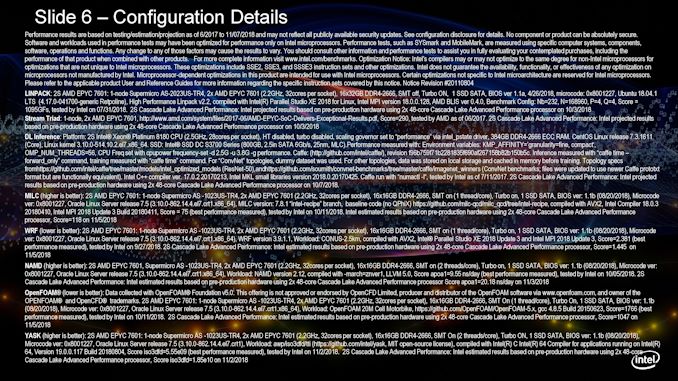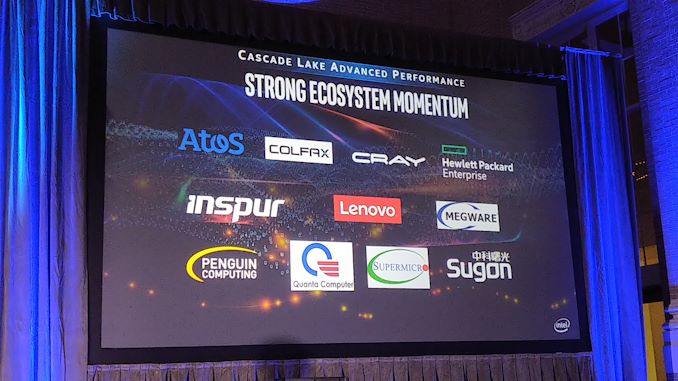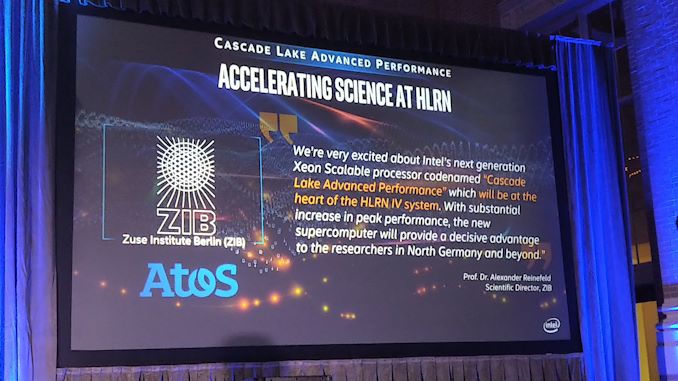Intel Offers More Cascade Lake-AP Performance Numbers
by Ian Cutress on November 11, 2018 6:15 PM EST- Posted in
- Enterprise
- Intel
- HPC
- Enterprise CPUs
- Cascade-AP

One of the announcements from last week involved Intel and its new Cascade Lake Advanced Performance category of processors to launch next year. These new processors will be based on combining two 24-core Cascade Lake-SP processors on a single package substrate to offer a single socket 48-core option with a total of twelve memory channels. The Cascade Lake-AP parts are going to be launched next year, and until then Intel is putting out some internal benchmark numbers.
Vendor Benchmark Results
When we are this far away from a product launch, all benchmark numbers should be taken with a grain of salt. This goes doubly so for vendor supplied benchmarks. However, Intel is on the warpath to promote what it sees as a new product family within its portfolio, even if it is only set to come out next year.
At the announcement last week, Intel offered Linpack and Stream Triad as two main high-performance metrics as comparison. Today Intel is also offering more ‘real world’ metrics. These metrics are, to quote Intel, ‘estimates based on pre-production hardware’. This means that the hardware is not ready yet, and these are values based on the engineering samples running but extrapolated to an expected benchmark value. Add another dump truck of salt on these numbers.
Intel’s official list of results are as follows:
| Intel's Benchmark Numbers for 2S 48 Core Cascade Lake-AP |
||
| Benchmark Type | Score vs 2S EPYC 7601 | |
| *These numbers were created by Intel | ||
| Linpack | Numerical Linear Algebra | 3.4x |
| Stream Triad | Memory Bandwidth | 1.3x |
| MILC | Quantum Chromodynamics | 1.5x |
| WRF | Weather Forcasting | 1.6x |
| OpenFOAM | Computational Fluid Dynamics | 1.6x |
| NAMD (APOA1) | Molecular Dynamics | 2.1x |
| YASK (ISO 3DFD) | HPC Kernel Tuning | 3.1x |
The slide with this data is in the gallery below.
In each case, Intel is comparing a dual-socket Cascade Lake-AP system with a dual socket EPYC 7601 system. Intel’s information slides go through how it set up all of its AMD systems in detail, however it does not disclose how the Cascade Lake-AP systems are set up by comparison, presumably as to not disclose any additional set-up numbers.
For the most part, we don’t put much stock into vendor supplied benchmark numbers. It’s easy for a vendor to claim a multiple when doubling particular compute resources, but when it comes to real world tests, companies like Intel have to try and promote its future products to potential customers. This is what this is. However, no matter how many numbers come out, these are impossible to verify independently. Wait until the AnandTech review, of course.
Intel also disclosed a number of ecosystem partners who are getting ready to deploy Cascade Lake-AP, as well as an offical declaration of the Cascade Lake-AP deployment at HLRN.
Cascade Lake-AP is set to be launched alongside the Cascade Lake-SP in the first part of 2019, although Intel states that Cascade Lake-SP will ship for revenue in 2018. This week we are at the Supercomputing trade show - hopefully there will be a demo somewhere that we’ll be able to see and talk about.



















52 Comments
View All Comments
Karmena - Monday, November 12, 2018 - link
Please remember that AMDs numbers are also FUD, as those are also a vendor supplied numbers and just 1 test. But yes, that test did give a glimpse of what is coming as this Intel system, in reality, is just nerfed 28core 4 socket system.Also, i am worried of lack of glue in this article. So, let the GLUE wars begin. Who has better GLUE - AMD or INTEL or AMD?
danjw - Sunday, November 11, 2018 - link
Nothing but FUD, until outsiders actually get silicon to test!MattZN - Sunday, November 11, 2018 - link
Intel's 'benchmarks' are worthless without power consumption figures to go along with them.Which I'm sure Intel would be happy (NOT!) to supply. And I'm sure they continue to use their whole toolbox of shenanigans. Maybe anandtech should formally ask Intel for this information and make it crystal clear to readers that Intel refuses to provide any of it.
Being fair, AMD didn't disclose exact Zen 2 power figures either, but AMD did say 'half the power at the same clock', on a per-core basis. That is fairly definitive. That means the 64-core AMD Zen 2 EPYC is going to consume roughly the same power as their 32-core part does right now, for twice the performance. At a minimum. AMD is still holding back really describing how the doubled FP performance per core (yielding 4x the performance when cores are also doubled) fits into the power consumption specs.
-Matt
CBeddoe - Sunday, November 11, 2018 - link
You're right on the money.Power consumption and efficiency are what really matter for Data Centers.
If they have the same crew runn those benchmarks as they did at CES its probably running at 20kwatts with a 20kwatt phase change cooler and a hacked motherboard.
AMD at least has a process shrink to help drive efficiency a bit how much remains to be seen but their claims of 25% aren't off the wall.
mode_13h - Monday, November 12, 2018 - link
Actually, AMD did say they doubled the width of their vector pipelines to 256-bit.yannigr2 - Monday, November 12, 2018 - link
Don't expect half power consumption, considering that the I/O chip is still at 14nm. But it will be that much lower that it will make any Intel AMD power consumption comparisons laughable at best. Think what is happening with Nvidia/AMD GPUs but this time with AMD having the clear advantage.Gondalf - Monday, November 12, 2018 - link
Don t be so confident, Xeon AP will be low clocked like Rome, in these conditions 14nm++ is pretty in line with 7nm (early) power savings. Rome will be hot unfortunately.Intel is right now selling Xeon AP because customers have the exact power figures of Rome (AMD always share the data six/eight months before shipment to have an idea of the volume to order to foundry)
MonkeyPaw - Sunday, November 11, 2018 - link
In other words, “hey, please delay your next order until we can get out act together!”EPYC 2 sounds like it will have more IPC and better clocks, not to mention memory bandwidth gains. We won’t be asking how Intel’s next CPU compares to AMDs old CPU.
Spunjji - Monday, November 12, 2018 - link
This is what's making me laugh. They insist on comparing to a product that will be old news when theirs releases, assuming it releases on time.I wonder how much they paid out in "marketing development funds" to get all those partner logos on their slides. :D
shabby - Sunday, November 11, 2018 - link
Did they mention if they're using Elmer's glue or gorilla glue? 🤔